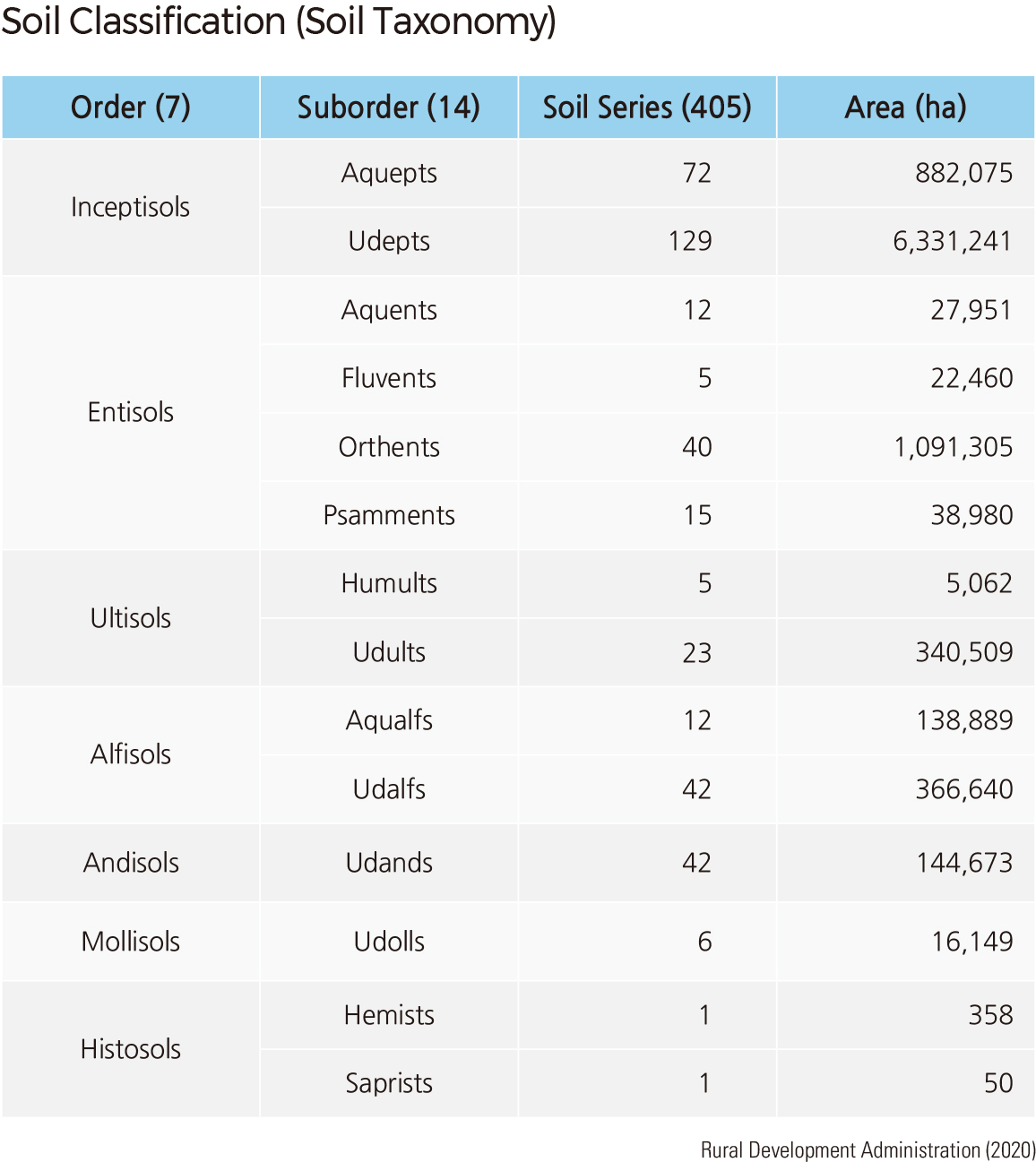English II 2020
Korea has a fairly homogenous climate and vegetation pattern throughout its territory, but its soil distribution pattern is quite complex. This can be attributed to the country's long history of intensive land use, diversified geological features, and rough terrain. Current classifications are generally made by utilizing the Soil Taxonomy established by the United States Department of Agriculture (USDA). For forest soil, a different three-stage forest soil classification method is applied that considers soil color, moisture conditions, and shape of a soil profile.
According to the Soil Taxonomy (which categorizes 14 orders of soil recognized globally), Korea has seven orders, 14 suborders, and 32 great groups of soils. In addition, approximately 400 soil series (the lowest level of soil classification) have been identified to date. Inceptisols, which can be defined as soils that do not have clear soil horizon development, cover 76.7% (7.21 million ha) of Korean territory. The predominance of Inceptisols indicates that the land surface has undergone radical changes. For instance, rapid soil erosion constantly removes topsoil from slope surfaces, and active deposition in areas such as alluvial fans, valleys, and riverside flats hinders soil horizonation. The characteristics of Korean summers also serve as crucial factors of fast erosion; concentrated precipitation, high temperatures, and high humidity interrupt the accumulation of organic matter and weaken soil formation processes. Additionally, freezing during the winter also prevents active differentiation of soil horizons.
Entisols, occupying 12.6% (1.18 million ha) of Korea, have a weakly developed A horizon. Even in flat areas, Entisols are commonly considered infertile as they have a low nutrient status and a decreased capacity for water storage. Seventy-three soil series are currently classified as Entisols, and four subgroups have been identified. Entisols are predominantly concentrated in major mountain areas, such as Taebaeksanmaek and Sobaeksanmaek, where active soil erosion occurs. Psamments (often found in sand deposits and shifting sand dunes) and Fluvents/Aquents/Orthents (mostly formed on riverbanks and tidal mudflats) are some identifiable suborders of Entisols.
Alfisols and Ultisols have well-developed B horizons that characteristically appear in clay-enriched argillic horizons. These soils occupy 5.4% and 3.7% of the land, respectively. Alfisols are located in riverside flatlands or on hillsides composed of neutral or basic rocks. Ultisols are acidic and can usually be found along hillsides or foothills consisting of acidic rocks.
Andisols are formed in volcanic rocks and are mainly distributed on volcanic islands that were formed during the Quaternary eruption (such as Jejudo and Ulleungdo). They also appear in inland regions, where they show the local distribution in the Tertiary volcanic rock zones along Taebaeksanmaek, Sobaeksanmaek, Gyeonggi-do, and the northern part of Gangwon-do. Andisols, however, only occupy 1.5% of the total area of South Korea.
Histosols are developed in organic-rich environments. They can be observed throughout the coastal area of the South Sea and Jejudo. On the other hand, Mollisols are common in the valleys of northern Sobaeksanmaek and southern Gangwon-do. Mollisols are soils illuviated with organic matter and nutrients.
Korea is well known for its success in combating land degradation. By the end of the Joseon dynasty, many of its mountains were devastated due to long years of slash-and-burn farming and firewood logging. The Japanese Colonial Period and the Korean War that followed only further deteriorated the situation through severe forest degradation and consequent soil loss. Since the 1970s, however, many barren mountains have successfully been transformed into lush green forest areas, and soil quality has steadily improved. Korea's case of overcoming land degradation serves as a valuable example of sustainable development, particularly for developing countries. |

